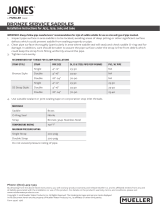
-INSTALLATION-
MUELLER
®
PACK JOINT FOR
PE PLASTIC OR COPPER TUBING
-INSTALLATION-
MUELLER
®
PACK JOINT FOR
POLYVINYLCHLORIDE (PVC) PIPE
3) Remove the nut assembly (which includes the nut, screw, slip washer and gasket) from the tting body, without
removing the parts inside, and slide the nut assembly onto the tubing or pipe end.
4) Insert the tubing or pipe into the body of the tting until it contacts the stop inside the tting. (If there is no stop in
the tting, insert the tubing or pipe 1” into the body of the tting.)
5) Slide the nut and gasket assembly forward and tighten Pack Joint Nut 1 to 1-1/2 turns after gasket starts to
compress (if there is no stop in the tting, hold the tubing or pipe to prevent it from sliding further into the tting).
Tighten in the same way tapered pipe threads of the same nominal size would be tightened (see installation hints,
below).
6) Tighten the clamp screw using a socket or box end wrench so the serrations in the clamp hold the tubing or pipe
securely. Use of a socket or wrench is recommended over a screwdriver.
7) Pressure test for leakage before backlling in accordance with ASTM D2774, latest edition.
INSTALLATION HINTS:
• If installer is unfamiliar with this style of connection, practice on ttings in the shop and pressure test to
verify proper technique. Once the installer has the “feel” of tightening this type of connection, dependable
leakfree connections are easy to make.
• Inspect and test all connections before backlling so leaks can be detected and repaired without having to
re-excavate. It is costly to nd and repair leaks after backlling.
• Use extra care if using tubing or pipe over 1” in size, or if higher water pressures are involved.
3) Insert tubing into body of tting until it contacts the stop inside the tting. (If there is no stop in the tting,
reference to Form #12547, Installation of Compression Style Connection without Pipe Stop.)
4) Slide the nut and gasket assembly forward and tighten Pack Joint Nut 1 to 1-1/2 turns after gasket starts to
compress (if there is no stop in the tting, hold the PVC pipe to prevent it from sliding further into the tting). Tighten
in the same way tapered pipe threads of the same nominal size would be tightened (see installation hints, below).
5) Tighten the clamp screw using a socket or box end wrench so the serrations in the clamp hold the PVC pipe
securely. Use of a socket or wrench is recommended over a screwdriver.
6) Pressure test for leakage before backlling in accordance with ASTM D2774, latest edition.
INSTALLATION HINTS:
• If installer is unfamiliar with this style of connection, practice on ttings in the shop and pressure test to
verify proper technique. Once the installer has the “feel” of tightening this type of connection, dependable
leakfree connections are easy to make.
• Inspect and test all connections before backlling so leaks can be detected and repaired without having to
re-excavate. It is costly to nd and repair leaks after backlling.
• Use extra care if using PVC pipe over 1” in size, or if higher water pressures are involved.
Pack Joint
Pack Joint
WARNING:
The safe and reliable performance of this product requires correct installation only on the specic type of
tubing or pipe described in the product literature, and which has been manufactured and veried by the installer
to comply with the dimensional and physical performance criteria as set forth in the pertinent AWWA/ASTM
standard for the tubing/pipe. Improper installation or use of this product on non-standard material could result in
failure of the connection with the potential for serious bodily injury and/or property damage.
WARNING:
The safe and reliable performance of this product requires correct installation only on the specic type of
tubing or pipe described in the product literature, and which has been manufactured and veried by the installer
to comply with the dimensional and physical performance criteria as set forth in the pertinent AWWA/ASTM
standard for the tubing/pipe. Improper installation or use of this product on non-standard material could result in
failure of the connection with the potential for serious bodily injury and/or property damage.
Liner
PE Tubing or Pipe
PVC Pipe
CAUTION: Check the markings on the NUT to determine the specic tubing material for which the connection is
designed: marked “CTS” for copper tubing or copper tube size PE – “PEP” for iron pipe size PE.
IMPORTANT: A rigid, solid tubular stainless steel liner must be used inside the end of polyethylene plastic to prevent
it from collapsing as the connection is tightened, and to provide support to allow the gasket in the connection to
establish a reliable seal.
1) End of tubing or pipe must be round, cut straight, free of burrs, and clean.
2) For PE plastic tubing or pipe, push the appropriate size of liner in until the are on the liner rests solidly against
the end of the tubing or pipe, as shown.
CAUTION: Check the markings on the NUT to determine the specic tubing material for which the connection is
designed: marked “PVC" for Polyvinylchloride Pipe.
1) End of PVC pipe must be round, cut straight, free of burrs, and clean.
2) Remove the nut assembly (which includes the nut, screw, slip washer and gasket) from the tting body, without
removing the parts inside, and slide the nut assembly onto the PVC pipe end.
WARNING:
Do not use a compressible medium such as air to check for water tightness – doing so could result in an
explosive failure causing serious bodily injury or property damage.
WARNING:
Do not use a compressible medium such as air to check for water tightness – doing so could result in an
explosive failure causing serious bodily injury or property damage.
Form 11910 Rev. 4/11 Printed in U.S.A.
Decatur, IL Decatur, IL


